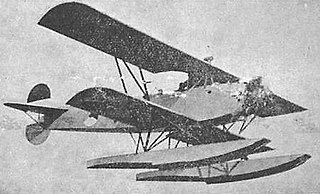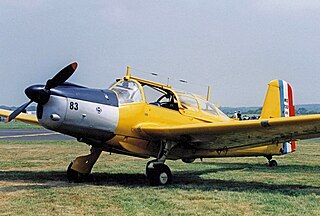
The Blackburn Shark was a British carrier-borne torpedo bomber built by the Blackburn Aircraft company in England. It first flew on 24 August 1933 and went into service with the Fleet Air Arm, Royal Canadian Air Force, Portuguese Navy, and the British Air Observers' School, but was already obsolescent by 1937 and in the following year, replacement by the Fairey Swordfish began.

The Hawker Hedgehog was a three-seat reconnaissance biplane, to be used for naval scouting, produced to meet Air Ministry Specification 37/22.

VL Viima, constructed by the State Aircraft Factory is a Finnish two-seat, biplane trainer used by the Finnish Air Force from the late 1930s to the early 1960s. After military service, several were released into civil use.

VL Kotka ("Eagle") was a Finnish two-seat, biplane maritime patrol aircraft, designed and built by the Valtion lentokonetehdas or VL. It was meant as a cheaper replacement for the outdated IVL A.22 Hansas that were in service with the Finnish Air Force.

VL Sääski II was the first series-produced aircraft designed in Finland. The aircraft was built by the State Aircraft Factory and was a two-seat, biplane, single-engine trainer constructed out of wood.

Valmet Vihuri was a Finnish advanced two-seat fighter trainer aircraft, serving in the Finnish Air Force between 1953 and 1959. Only a few airframes have survived, as in the Central Finland Aviation Museum in Finland.

The Valmet Tuuli was a trainer aircraft, developed for the Finnish Air Force by the State Aircraft Factory. The aircraft was to be produced in 3 different versions. The last version, Tuuli III was redesigned from scratch, and is basically an entirely different aircraft.

The Armstrong Whitworth Atlas was a British single-engine biplane designed and built by Armstrong Whitworth Aircraft. It served as an army co-operation aircraft for the Royal Air Force (RAF) in the 1920s and 1930s. It was the first purpose-designed aircraft of the army co-operation type to serve with the RAF.

The Luton Buzzard was a 1930s British single-seat, open cockpit ultralight aircraft built by Luton Aircraft Limited.

The Avro Club Cadet was a 1930s single-engined British biplane trainer aircraft, designed and built by Avro as a development of the earlier Cadet. It was planned for private and club use and, unlike the Cadet, was fitted with folding wings.

The Morane-Saulnier MS.230 aircraft was the main elementary trainer for the French Armée de l'Air throughout the 1930s. Almost all French pilots flying for the Armée de l'Air at the outbreak of World War II had had their earliest flight training in this machine. It was the equivalent of the Stearman trainer in the United States air services and the de Havilland Tiger Moth in the British Royal Air Force.

Klemm L 25, later Klemm Kl 25 was a successful German light leisure, sports and training monoplane aircraft, developed in 1928. More than 600 aircraft were built, and manufacturing licenses were sold to the United Kingdom and the United States.

The Zlín Z-XII was a Czechoslovak two-seat sports aircraft, and the first major design success by the Zlínská Letecká Akciová Společnost (Zlín) aircraft manufacturing company, after its founding in Otrokovice after the takeover by the Bata Group.

The SET 7 was a military trainer and reconnaissance aircraft that was produced in Romania in the mid-1930s. It was originally designed as a conventional single-bay biplane, with slightly staggered wings, a standard undercarriage with fixed tailskid, and a tandem open-cockpit arrangement for the pilot and instructor or observer. Power was supplied by an Armstrong Siddeley Jaguar radial engine, and from the outset the aircraft was equipped for wireless and photographic reconnaissance duties.

The Fokker C.VII-W was a reconnaissance seaplane built in the Netherlands in the late 1920s. Sharing elements of the highly successful C.V design, the C.VII-W was a conventional, single-bay biplane with wings of unequal span braced with N-struts. The undercarriage consisted of a standard twin-pontoon arrangement, and the fin and rudder continued through to the ventral side of the fuselage, creating a cruciform tail. The pilot and observer sat in tandem, open cockpits. The wing structure was wooden with fabric and plywood covering, and the fuselage was of steel tube construction with fabric covering.

The Heston JC.6 was a British prototype air observation post aircraft designed and built by the Heston Aircraft Company Limited, who had previously built the Heston Phoenix, the Heston T.1/37 and the Napier-Heston Racer. The JC.6 was also known as the Heston A.2/45 or the Heston AOP.

The Morane-Saulnier Alcyon is a two or three-seat basic training monoplane designed and built in France by Morane-Saulnier.

The Westland Weasel was a prototype British two-seat fighter/reconnaissance aircraft of the First World War. Designed to replace the Bristol Fighter, the Weasel was a single engined tractor biplane. Four prototypes were built, but no production followed owing to the failure of its original engine, although the prototypes were used as engine test beds for the successful Armstrong Siddeley Jaguar and Bristol Jupiter engines.
The Armstrong Whitworth A.W.29 was a British bomber aircraft built by Armstrong Whitworth Aircraft.

The IAR-22 was a single engine basic trainer built in Romania in about 1934. It was a low-wing monoplane with two seats in tandem and a fixed conventional undercarriage.




















